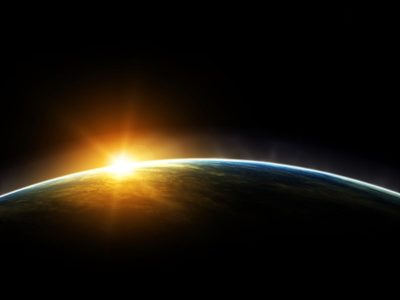. . . We experience the universe as the city of man. It is a field of human exploration and
endeavor from which the gods have fled. . . .This is the age of the secular city.
— Harvey Cox, The Secular City (1966)
The tribes that united to form a city never failed to light a sacred fire, and to adopt a common religion.
—Fustel de Coulanges, The Ancient City (1873)
Tribe, Village, and Technopolis
During his brief stint as a prophet of secularization, Harvey Cox wrote his best seller, The Secular City (1966). There he argues that organized human community has developed from tribe to village to modern technopolis. Though he completely fails to understand what Scripture and the Christian worldview have to say to the modern city, he does give a fairly accurate description of the pagan village and the worldview on which it was founded. He understands as well something of how Christianity challenged that foundation. Cox writes:
Presecular man lives in an enchanted forest. Its glens and groves swarm with spirits. Its rocks and streams are alive with friendly or fiendish demons. Reality is charged with a magical power that erupts here and there to threaten or benefit man. Properly managed and utilized, this invisible energy can be supplicated, warded off, or channeled. If real skill and esoteric knowledge are called into play, the energies of the unseen world can be used against a family foe or any enemy of the tribe (19).
Cox is naïve about the demon-haunted world outside ancient Israel. The Romantics suffered from a similar naiveté. Wordsworth, for example, thought that he would enjoy catching a glimpse of “Proteus rising from the sea,” but as C. S. Lewis points out, that was probably because he was sure he never would. Pagan spirits become terrifying the moment they become real. And the demons and magic of the ancient world were very real.
But Cox is right when he describes the “continuity of Being” philosophy that underlay the city-states and empires of the ancient world.
Man and nature, the animals and the gods, all form one continuous life process whose meaning courses through it just below the surface and can erupt anywhere in a transparent moment of magical or religious power (9).
If man is inseparable from Nature, if Nature is essentially divine, then all have a common life and a common life force. This is pantheism. It is also the worldview of the sorcerer.
The Sumerian, Egyptian, and Babylonian religious systems, despite their fantastically complicated theologies and their enormously refined symbol systems, remained a form of high magic, relying for their cohesion on the integral relation between man and the cosmos (19).
Cox further argues that the pagan world saw the cosmos in terms of space rather than time. The world was the given, self-existent and eternal. Things happened within the world, but nothing ever happened to the world, that is, to Being as such. History was of little concern. “History was subsumed under cosmology, society under nature, time under space. Both god and man were part of nature.” The flow of time was irrelevant; the world was eternal.
The Ancient City
But eternity manifested itself in the village or city. There the gods met man, and man became most truly himself; that is, divine. The ancient city, then, was in essence a religious institution, and “the foundation of a city was always a religious act.” Fustel de Coulanges writes,
Surrounded by a sacred enclosure, and extending around an altar, it was the religious abode of gods and citizens. Livy said of Rome, “There is not a place in this city which is not impregnated with religion, and which is not occupied by some divinity. The gods inhabit it.” . . . Every city was a sanctuary; every city might be called holy (141).
The ancient city-state was inescapably and totally religious. There was no separation of church and state: “. . . the state and religion were so completely confounded that it was impossible even to distinguish the one from the other, to say nothing of forming an idea of a conflict between the two” (167).
Christianity as Secularization!
As Cox lays the groundwork for his secular technopolis, he traces the whole modern process of secularization to three elements of Christian theology.
First, Cox argues that the biblical doctrine of creation overturned the continuity of Being philosophy on which the ancient city stood. “The Hebrew view of Creation . . . separates nature from God and distinguishes man from nature” (19). God’s absolute transcendence means the de-divinizing of the world.
Next, Cox points to the Exodus story. He claims that the Exodus desacralized politics. The Exodus “symbolized the deliverance of man out of a sacral-political order and into history and social change . . . .” Here, too, he isn’t wide of the mark. In the Exodus God destroyed the greatest merger of magic, politics, and technology the world had ever seen. He overthrew Egypt’s god-king in the Red Sea and humiliated all of her nature gods. Of course, this rejection of divine politics was already implicit in the doctrine of creation.
Finally, Cox appeals to the Mosaic Covenant and specifically to the Second Commandment, which forbids the making or keeping of graven images. Cox rightly points out that Yahweh’s ban on idols was a rejection of all man-created value systems, since “for the ancients, gods and value systems were the same thing.” From here Cox makes a huge leap. He turns his back on Sinai, scorns “ethical anarchism and metaphysical nihilism,” and embraces the pragmatic secularizing of all human values. Man must make up his own rules to fit his current needs.
All idols and icons must be exposed for the relative, conditional things they are. Tribal naiveté must be laid to rest everywhere, and everyone must be made a citizen of the land of broken symbols (30).
Once everyone abandons his imagined absolutes, once every society and culture admits that it values are relative, then the whole world can work at creating a pragmatic value system that can benefit everyone. John Lennon writes “Imagine” with a similar perspective. So here’s Cox moving to the logical outworking of his theology:
“Thus it is now possible for the United Nations to develop a Declaration of Human Rights based on a consensus of all the nation-states involved.” There will be no more appeal to “Nature and Nature’s God” or to some theory of natural law. Fifty one percent and the human consensus must rule with an iron fist. “Secularization places the responsibility for the forging of human values, like the fashioning of political systems, in man’s own hands” (31).
But in all of this Cox ignores the obvious. In scorning human idols, God asserts the absolute authority of His own word, of His revealed laws, over all human institutions. God dismisses all values systems as relative except His own. He insists that His own word is law and seems to brook no rivals in this regard.
The City of God
Cox rightly sees that Christianity overturned the pagan philosophy of the continuity of Being, but he fails to see or understand the total claims of the transcendent Creator. Rousas J. Rushdoony writes:
By de-divinizing the world, Christianity placed all created orders, including church and state, alike under God. By denying divinity to all, and by reserving divinity to the triune God, all created orders were freed from one another and made independent of each other and together interdependent in their dependence on God. Church and state were alike required to be Christian, but neither was able to be total Christian order (124).
Huge point here: This means that the kingdom or City of God is more than the institutional church. It is Christ’s redemptive reign over all of life; it is the community of the redeemed in all of their relationships and activities under the Lordship of Jesus Christ.
Jehovah-Shammah
In the final chapters of his prophecy, Ezekiel sees the coming City of God. The emphasis throughout these chapters is the new Temple—gospel-centered worship. Little space is given to the City itself. But as the prophet closes his book, the prophecy draws back for a moment to show us, as it were, an aerial view of the City of God. Ezekiel briefly describes its gates; and then he tells us the city’s name: “. . . and the name of the city from that day shall be, The LORD is there” (48:35). In Hebrew, it is Jehovah-Shammah.
God’s presence with His people is more than His immanence within creation or even His providence on their behalf. God dwells with His people, first of all, in the Person of Jesus Christ. In Christ, God became man. (That’s why we celebrate Christmas!) And through His word and Spirit, He dwells with and in His people so that we are in truth “flesh of His flesh and bone of His bone, and live and are governed forever by one Spirit, as members of the same body are governed by one soul” (Heidelberg Catechism). The Church of Jesus Christ is the New Jerusalem, God’s Tabernacle with men.
Matthew Henry summarizes the promise of Ezekiel 48:35 with these words:
Where the gospel is faithfully preached, gospel ordinances are duly administered, and God is worshipped in the name of Jesus Christ only, it may truly be said, The Lord is there . . . The Lord is there in his church, to rule and govern it, to protect and defend it, and graciously to accept and own his sincere worshippers, and to be nigh unto them in all that they call upon him for. This should engage us to keep close to the communion of saints, for the Lord is there; and then whither shall we go to better ourselves? Nay, it is true of every good Christian; he dwells in God, and God in him; whatever soul has in it a living principle of grace, it may be truly said, The Lord is There.
Conclusion
The city of the future isn’t the demon-haunted city of the pagan world or the sterile, pragmatic technopolis of Cox’s vision. It is Jehovah-Shammah, the eternal City of God, within whose borders we may even now sojourn by faith. It is a community of truth and grace, of law and love, of real human community and the real presence of God. To enter its gates, we must be born again.
For Further Reading and Listening:
Rousas J. Rushdoony, The One and the Many, Studies in the Philosophy of Order and Ultimacy (N. p.: Craig Press, 1971).
Harvey Cox, The Secular City, Secularization and Urbanization in Theological Perspective (New York: The Macmillan Company, 1966).
Numa Denis Fustel de Coulanges, The Ancient City (Garden City, NY: Doubleday, 1955).
 Off The Grid News Better Ideas For Off The Grid Living
Off The Grid News Better Ideas For Off The Grid Living





